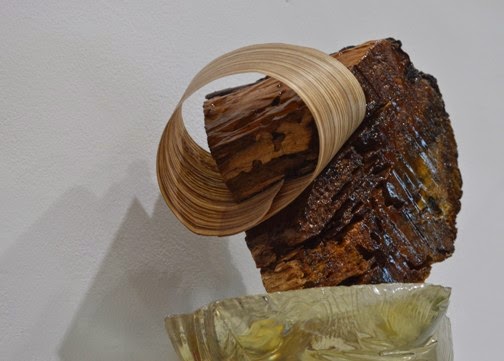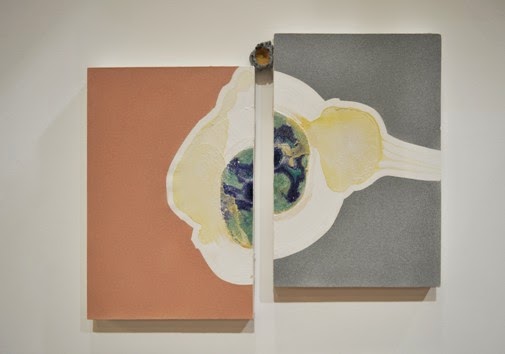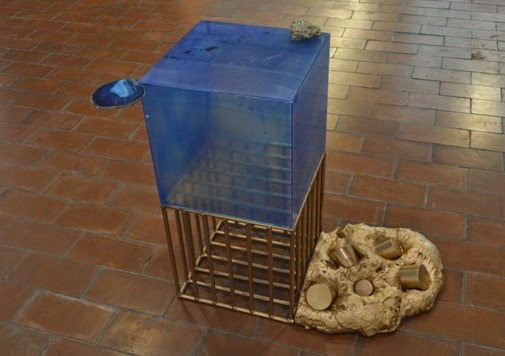
Matt Gee: Natural Simulations @ Husk gallery London
Departing from his fascination with geological phenomena, the new body of work of British artist Matt Gee explores the physical appearance of earthly beauty juxtaposed against artificiality and socio-political metaphors. Entitled Natural Simulations, the new show presented at Husk gallery encompasses an amalgamation of sculptural works alongside C-type prints and a video installation. Painstakingly experimenting with a wide range of mediums, such as expanding foam and crystal chemicals, Gee creates his own ‘cabinet of curiosity’ version as his centrepiece, reflecting concise connotations of ecological, cultural and economic character. Concurrently, investigating parameters concerning aspects of materialism and authenticity, the exhibition emerges as a great study of humanity and the contemporary world through the eyes of a young artist.
Matt Gee talked to REVma -/+ about his exhibition and work:
REVma -/+: What esoteric process engaged you with the chosen narrative of your exhibition?
M.G.: A new body of work has been developed specifically for the show, Shelves of: Faux Specimens Genuinely Archived, which has been made to fit a 6m. wall of Husk. This wall-based installation adopts a ‘Cabinet or Curiosity’ format which consists of an extensive series of works acting as an archive of artificially made objects posing as natural forms, and artificial forms posing as natural processes that conform to synthetic objects.
I’m fascinated with the idea of geodes existing in their original natural environment as undiscovered objects within a baron wilderness of rock. Initially they appear as dull pebbles or rocks, but only the sharpest of visions can realise their potential by discovering them and then proceeding with cracking them open and revealing their beautiful crystallised interior, at which point this becomes a desired ornament.
Carrying this element of surprise and wonder within a mundane looking object, geodes act as a metaphor for how appearances on the outside may not always represent what lies within, and conjuring up suggestions of the obsessive explorer trekking across volcanoes in search of this desired ornament.
I make these fabricated geodes from expanding foam (polyurethane) laced with crystals that I’ve produced over time. I see the foam as a material that has both negative and positive connotations; a high pollutant, yet a tool for permanence with DIY and insulation purposes making it environmentally beneficial.
I’ve used certain types of unorthodox paint as a starting point to create artifice, through carefully cultivating free flowing materials to appear as a natural process conforming to man-made found objects. Using materials such as enamel paint or crystal solutions, which although don’t contain DNA, grow in an organic and life-like fashion, then forming a process which allows them to physically conform to found materials (such as duck tape, a bomb shell, geometric area on a surface I’ve created).

REVma -/+: What were the challenges working with your mediums, and, especially those encompassing the use of crystal chemicals?
M.G.: As with most materials, trial and error is all part of the artistic journey. However, with industrial chemicals being used such as copper sulphate, magnesium potassium sulphate, and the artist acting as amateur scientist is bound to throw up an increased level of failures, experiments and challenges. Due to the chemicals being irritants there are certain precautions necessary for the process that need to be in place, but sometimes in the heat of the studio moment, these precautions are sometimes skipped resulting in the occasional rash.
The main challenges are finding the correct formula that works for my practice, in terms of depth or width of the sculpture, thickness of crystals desired, or the surface texture I’d like to grow the crystals on. The process can be frustrating in a mundane and practical sense, if the solution is too dense and crystallises too quickly before even leaving the pipette or syringe. The opposite can happen too with crystals not crystallising within a sculpture over a period of weeks and then having to pour the solution down the sink and wait another month for the same sculpture to form.
This level of risk and failure can apply to most practices, and the failures or rejections contribute to the final outcome as much as the final works that are on display in the gallery.

REVma -/+: To what extent do you believe art can generate statements on socio-economic situations on a local or even global scale?
M.G.: My statements are subtle, with motifs leading the viewer to ideas of pollution, mass production, or capitalism. The motifs could be the name of a stone effect paint relating to geographical locations being artificially brought together; i.e. Grand Canyon Red, and in a fictional and rather humorous sense, Gotham Grey being used for two halves of the same artificial geode.
Another important factor for this show was the display methods, the shelves I chose to use were in order to echo two cold aesthetics, of both the scientific world and the slick corporate/luxury flat aesthetic. There is a statement about socio-economic situations by imitating natural objects and presenting them within a context that heavily references the ambiguous boundary between a luxury flat and a museum display method. I’d like to ask questions, such as ‘what’s the difference between having a collection of fake geodes and having a fake pot plant of an orchid?’
In the public realm and outside of the gallery, there are many examples where a gallery has opened; put on exhibitions and in turn small businesses such as coffee shops or pubs in the close vicinity have thrived from the influx of footfall to the area. This can work twofold as the businesses can send the footfall back to the galleries, and there are many examples of how different formats can co-exist in successful communities.
Potentially there is the downside, with the model leading to strong levels of gentrification, and perhaps housing developers losing sight of what made an area ‘edgy’, ‘upcoming’ or ‘desirable’ in the first place, which then can possibly lead to a lack of affordable space and artists leaving that area which can also be turned into a positive statement in itself.
Regarding taking artwork into the public realm, a public sculpture has the potential of being a subliminal statement that can then lead to changes in socio-economic structure. If it brightens up a courtyard, creates conversation, stimulates social activity, then all of a sudden there is more of an influx to that area and people enjoy spending time there which can then lead to an influx in business and subsequently increasing the rent in that area.
REVma -/+: As a young artist, do you feel that contemporary art should serve decorative purposes or also engage with current affairs and stimulate debate, or both?
M.G.: All of the above; although, I’ll probably think the same when I have become an older artist. I enjoy art that engages with current affairs on some level, but I believe portraying public affairs is problematic. Keeping up with current affairs is impossible, as sometimes even the news channels have trouble doing this, and evidently with more scrutiny we are beginning to question how the news is edited in terms of which stories are picked up to broadcast.
I think art that’s purely made in decorative purposes can stimulate debate as much as art that’s purely conceptual. As long as the artwork is technically well executed, and the viewer is willing to engage for a moment and then subsequently appreciate, accept, or reject the work then there is an even playing field so to speak. Work can be decorative but still serves a historical purpose for its high quality and the moment in time it was created. An example of this would be the work of William Morris inspiring artists such as David Thorpe; his work will always be critically engaged with.
Artwork which references current affairs or has an agenda is always very interesting, but that’s not to discount art that doesn’t. Art can be purely ironic, apathetic, as long as it’s confidently thought out, executed to a high standard of intention, and not an imitation of another artists work. All these factors are subjective in terms of the viewer, but being exposed to more artworks over time can allow the viewer to contextualise the work more accurately, but as with all walks of life, there is an element of chance.
REVma -/+: Where do you see your visual lexicon taking you and your art in the years to come?
M.G.: Time is a concept in itself and I have short and long term goals. It’s daunting to predict where my art will take me in the years to come at this precise moment, as I feel that with this show I have successfully realised and completed a body of work, for now.
I travel to Iceland this May for a short two-week residency at an isolated farm situated on a lava field. I’m sure experiencing these surroundings and attempting to catch fish for lunch will bring new visuals that can be fused into my work. I plan to make quick works in situ in and around volcanic lava caves, thus occupying a natural space rather than a man-made space (without damaging or interfering the surroundings) and then carefully document them, resulting in archival images being selected and assimilated into an installation later in the year.
If I look back a couple of years since completing my Masters, and completing my degree 3 years prior, my visual language has developed but I’ve always carried forward the same burning desire to explore the possibilities and limits of different materials in order to explore authenticity and materiality. This then leads to creating work that subtly explores the balance of purity and wonder, along with humanity’s negative impact on the environment. Formally, viewers should expect large-scale collections or objects and paintings ranging in size, more so rather than large-scale individual works, but a continuation of large scale installations and arrangements.
